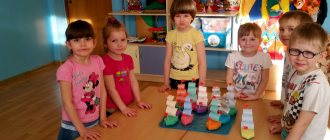Methodological recommendations “How to prepare and conduct an open screening” methodological development
Guidelines
How to conduct an open show in a kindergarten in a new way.
Ksenia Belaya, Ph.D. ped. sciences,
laureate of the Russian Government Prize in the field of education,
Honored Teacher of the Russian Federation
An open show is an event at which a teacher presents his work experience and achieved results to colleagues.
In methodological work there are two types of open demonstration - educational open demonstration and master class. They differ in their goals, which are formulated by the senior educator.
The purpose of the educational open demonstration is to introduce teachers to new forms of organizing educational activities or methods, techniques that they have not used in their work before. An educational open demonstration is conducted by a teacher or senior teacher as part of a seminar to familiarize teachers with new technology, for example, on the topic “How to organize research projects with preschoolers.” In this case, the educational open demonstration illustrates the theoretical principles that the senior educator talks about at the seminar.
Preparing for a training open show. To conduct a training open demonstration, you need to: determine the purpose of the event; choose the form and venue; think over the conditions, methods and techniques; make notes; plan preliminary work with children. At the same time, the teacher does not “rehearse” educational activities with children that he will show to colleagues.
An important stage of the educational open display is the conversation at the end. Its goal is to answer teachers’ questions, explain and clarify the new knowledge they have received. If the senior teacher is confident that the teachers have understood and accepted the basic guidelines, he invites them to independently prepare and conduct such an event with the children of their group. This could be a series of open demonstrations as a report from teachers on how they have mastered new methods and techniques.
The purpose of the master class is to acquaint the team with the pedagogical experience of a particular teacher, his original findings, and everything with which he was able to achieve high results. That is, the master class is conducted by a teacher-master, whose experience has already been generalized as the author’s system of work.
Preparation for the master class. The master class consists of two main parts: showing fragments of work with children and working with teachers in order to convey teaching experience. A master teacher thinks in advance about how to demonstrate his work with children to his colleagues, discuss the results he has obtained and tell him what methods and techniques he used to achieve them. To do this, the master teacher must refer to the methodological, scientific literature that he studied and used in his work.
After the master teacher’s speech, the master class participants actively speak out, ask questions, debate and draw conclusions. So, regardless of the type of outdoor display, there are three parts that need to be followed. For more details, see the diagram.
Determine areas of responsibility at the stage of preparation for an open display
The teacher, who presents his work with children, and the senior teacher, who is responsible for scientific and methodological activities in the preschool organization, are responsible for preparing an open display (in any form). Therefore, at the stage of preparation for an open display, it is important to determine the area of responsibilities and tasks of everyone.
What is the teacher responsible for? The teacher writes a note or script depending on what routine moment he will present. Thinks through answers to possible questions from colleagues. During an open demonstration, it is important not only to present the positive results of the work, but also to talk about the difficulties that the teacher encountered and how he dealt with them. To do this, the teacher analyzes his work and records all his difficulties in order to voice them to his colleagues.
An open show is most often held in a group room, so the teacher also prepares in advance a developmental subject-spatial environment, developmental and play centers that he plans to use during the open show.
What is the senior teacher responsible for? The senior teacher acts as the organizer of the presentation of teaching experience as one of the methodological events. Therefore, he supervises the teacher at all stages of preparation for it and is present at the event. Before the screening begins, the senior teacher introduces everyone present to the topic of the open screening, talks about the teacher’s work system, and suggests questions that should be paid special attention to.
At the end of the open screening before the discussion, the first word is given to the teacher who presented his work experience. And then the senior teacher organizes a discussion, sums up the results and voices a joint decision. For example, implement this experience into work, transfer notes to the methodological office, or continue to summarize the teacher’s experience in order to present it at the district (district) level.
Six Traditional Open Display Requirements
1. Formulate the topic, goals and objectives that the teacher plans to achieve. 2. Select a form for holding an open display. 3. Assess the conditions for the show and plan the space. 4. Draw up a step-by-step OD plan, calculate the timing of the lesson. 5. Select visual, demonstration and handout materials. 6. Select teaching aids, think about how to use TSO, ICT.
Take into account the new requirements for OA and the characteristics of children
In order to conduct an open show in a new way and solve all the tasks, motivate children to work together, and surprise colleagues, the teacher must take into account modern requirements for educational activities, plan and conduct them together with children, and focus on the resources of the developing environment.
Mutual visits always cause an emotional outburst in the team, which imposes additional responsibility on the teacher for the quality of his work. Because of the excitement before an open show, teachers often formally formulate its objectives. They prefer the old forms of organizing an open display, when children sit at tables and answer questions. They do not use the group space, but are limited to a small set of equipment, which children do not always use during an open show. To avoid this, follow a simple algorithm.
Four modern requirements for open display
1. Think about how to activate children, increase their motivation for activity (identify means). 2. Select methods for constructing a dialogue with children, taking into account the characteristics of the group. 3. Select games from the card index (games with rules, didactic, finger games, role-playing games, board games). 4. Organize a modern educational environment: work in activity centers, workshops, mini-studios, laboratories.
Clearly formulate your goals and objectives. When setting goals, rely on age-related targets and the content of the Basic Educational Program of Preschool Education. Proper formulation of tasks will prevent conflicts with programs and allow them to be successfully solved. If the educational process is based on an original program, the open display must take into account its requirements.
Choose the form of open screening taking into account the interests of children. Modern preschoolers are oversaturated with impressions, so boring classes will not bring the desired result. To interest children during open space, use modeling of situational conversations and didactic speech situations, dramatization games, travel games, solving problem situations, organizing a creative studio or experimental research laboratory.
Any of the modern forms of organizing children's activities requires the creation of a modern developmental space. There are two options to solve this problem: create the RPSS in advance or do it along the way with the children.
Create display space in advance. Consider the location of the open display based on the nature of the activity: the free part of the room is for physical activity; mini-podium, screen - for dramatization games; arrangement of tables - for productive activities.
Plan activity space with your children. To do this, include the necessary time in the organizational part of the open display. The main advantage of this option is the active position of children who feel involved in a collective decision.
At the initial stage, give children a task to change the situation. For example, in a travel game: “You need to go on a journey and save the hero. But how will we get to Antarctica? Next, using a globe or map, the children jointly plot a route to a distant country. They discuss together how best to get there. They can fly on an airplane - a pair of chairs are built, or they can sail on a ship - they are built from large soft modules.
Creative tasks for children that activate the imagination require stress resistance and high communication skills from the teacher. After all, there will be a child who wants to instantly teleport or involve the president of the country himself in the problem. We need to not get lost and find solutions to support any children’s initiative.
Comply with SanPiN requirements for the duration and safety of ML. Conduct public screenings under normal conditions, for a generally accepted duration. Take into account the age characteristics of children: physiological and psychological. Build the content of the activity on material that they know and that evokes a positive emotional response in them.
Alternate mental and physical activities. Children get tired quickly if they stay in one position for a long time. To relieve tension, play games, use music or a relaxing melody.
Choose visual material. Focus on standard requirements: cultural and hygienic, age, size taking into account the age of children, artistic design. For example, the excessive attractiveness and novelty of toys and aids can distract the child from the main cognitive process.
Children are waiting for open screenings. They know that the teacher will prepare interesting material and it will be fun. To meet children's expectations, use a new generation of visuals: an interactive panel, a table or floor, a board with a multimedia projector. This will highlight your high level of ICT competence.
A ready-made cheat sheet will help your teachers prepare for the open screening, taking into account their status.
Cheat sheet for teachers “How to prepare and conduct an open screening”




